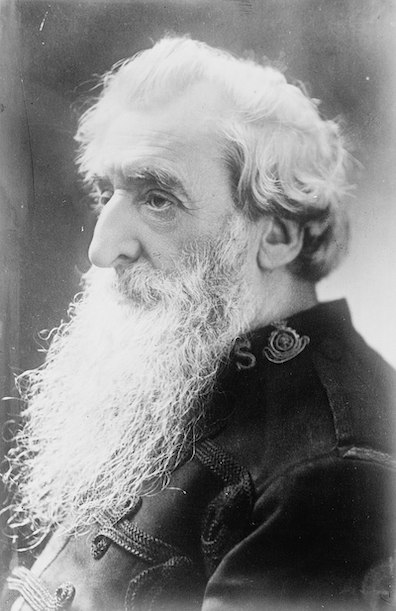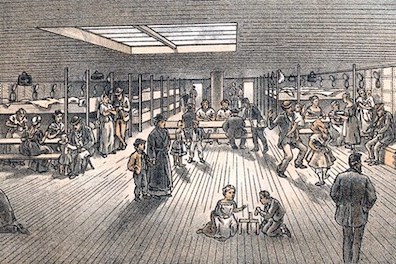Throughout the 19th
century London teemed with unfathomable numbers of unemployed or
underemployed people living in grinding, nearly inescapable
poverty. William Booth (1829-1912) began life as Charles Dickens
had, in a family slipping from prosperity into want. After
completing the apprenticeship into which his father placed him,
and moving to London to find work, he became an evangelist
preaching the Methodist doctrine: seek salvation by repenting
one's sins and practicing love for God and mankind. In 1865 he
and his wife Catherine founded a missionary and charitable
organization which in 1878 became known as the Salvation Army,
led by Booth as its "General." The Army brought three S's to the
poor: soup,
soap,
and salvation. In the 1880s it expanded from England into
Ireland, the United States, and Australia, and in 1890 Booth
produced a hard-hitting book,
In Darkest England, to
inform people about the sufferings and trials of the wretched
souls in their midst.
The title was provocative: it tweaked the English imperial
appetite for adventure narratives fed by books like Henry Morton
Stanley's
In Darkest Africa. Stanley was the
British-American journalist who in 1871 had famously found the
missing Scottish explorer David Livingstone ("Dr. Livingstone, I
presume?"). In 1890 he published
In Darkest Africa, the
story of his final exploration of the continent. Later in the
same year Booth published
In Darkest England; and the Way
Out, implying that the industrial revolution had made
England an uncivilized place, as full of hardship and
indifference as the darkest of continents. Bloom seems to be
aware of both books. In
Circe, recalling a cycling tour
that went amiss in the Irish village of Stepaside (west of
Killiney, a little beyond Dublin's southernmost suburbs), he
jokingly makes himself a Stanley-like explorer and reporter: "
I
who lost my way and contributed to the columns of the Irish
Cyclist the letter headed In darkest
Stepaside."
As for Booth's book, it is evoked by "
the submerged tenth,"
a phrase that Booth uses several times to argue that one in
ten English people are trapped in unconscionable poverty. The
second chapter, which takes the phrase as its title, is one of
several in which Booth quantifies his claims with hard numbers,
following Mayhew's practice of providing detailed numerical
estimates. The chapter also makes a more metaphorical call to
action that seems likely to have interested Joyce, though he
does not allude to it in
Ulysses: the "Cab Horse
Standard" for economic assistance. Booth observes that "every
Cab Horse in London has three things; a shelter for the night,
food for its stomach, and work allotted to it by which it can
earn its corn." Millions of London's human inhabitants, he
notes, are not afforded those minimal dignities or helped to
their feet when they collapse. Deploying Booth's phrase in a
chapter set in a cabman's shelter, Joyce may well have been
thinking of the Cab Horse Standard, but if so he did nothing to
call attention to it.
The word "
submerged," however, meshes intriguingly with
another element of the chapter's artifice.
Eumaeus is
filled with subtle, easily missed echoes of the 1912 Titanic
disaster, the great majority of them centered on evocations of
icebergs
or on the likenesses between the ship and
a
streetsweeper's horse. Might not "the submerged tenth"
figure in this design? More than 1,500 people died when the
great ship sank, many of them steerage passengers trapped behind
steel gates that sealed off their lower-level accommodations (C
through G decks) from those of the first- and second-class
passengers. These poor emigrants berthed below the waterline
might well be styled a submerged underclass, and when the ship
went down they were truly and permanently submerged.
Bloom's words about Dublin's poor may also recall the work of
the Danish-American muckraking journalist Jacob Riis
(1849-1914). Like Booth, Riis experienced poverty as a young
man. He lived a hard life after emigrating to New York City,
working in many dead-end jobs and sleeping in horrific
flophouses
before beginning a successful climb in the newspaper business.
As a reporter he turned his attention to the squalor and crime
of the city's slums, and in 1887, when he learned of the
invention of flash photography, he began supplementing his
writing with vivid images. He also took up lecturing on the
theme "The Other Half: How It Lives and Dies in New York." In
1890 he published a book,
How the Other Half Lives. Like
Booth's
In Darkest England, the book sold well and
inspired hopes of social reform. In 1892 a sequel followed:
Children
of the Poor.
One reason to suppose that Riis may be part of the picture is
the strange observation that denizens of the underclass "
were
very much under the microscope lately." Studied like
bacteria? Not exactly, but if one strips away the obscuring mist
of cliché and inept characterization that pervades
Eumaeus,
it seems that this could refer to the visual medium of
photography through which Riis hammered home his message.
Another hint of his presence may be found in the enumeration of
groups: "
coalminers, divers, scavengers, etc." Booth's
book is filled with affecting accounts of unfortunate
individuals, and he often refers to their occupations, but he
does not display a penchant for group labels. Riis does,
following a different precedent from Mayhew's work. His pages
teem with cigarmakers, shoemakers, ragpickers, pedlars, beggars,
tramps, thieves, toughs, firebugs, working girls, wives,
mothers. He also happily traffics in ethnic stereotypes as he
describes the Italians, the Irish, Russian and Polish Jews,
Chinamen, Negroes, Bohemians, Germans. It is easy to imagine
Bloom applying such language to his experience of the Dublin
streets: he has passed two "scavengers" at the beginning of
Lotus
Eaters, in an urban wasteland much like those depicted in
Riis's photos. The first Riis photo displayed here and the first
shot of
Brady's Cottages show a striking resemblance.
(Incidentally, Mayhew took great interest in scavengers,
studying the "pure-finders" who collected dog droppings for use
in tanneries and the "mudlarks" who dug in the slimy banks of
the Thames for things that could be sold.)
Many thanks to Vincent Van Wyk for the Titanic observation, for
a suggestion that Riis may occupy space with Booth in Bloom's
thoughts, and for a follow-up reflection––explored below––that
the motives of both Riis and Bloom may not be entirely pure.
Riis did aspire to promote social change, and he worked with
Theodore Roosevelt and others to achieve it, but his detractors
saw him as sensationalizing the lives of the poor for personal
gain. The term "muckraking," coined by John Bunyan in
Pilgrim's
Progress and popularized in the Progressive Era that
started in the 1890s, carried some negative connotations.
(Roosevelt held that "the men with the muck rakes are often
indispensable to the well being of society; but only if they
know when to stop raking the muck.") The comparably unsavory
term "slumming" dates to the same era. In both London and New
York in the final decades of the 19th century, wealthy people
frequently visited blighted ghettoes as a form of
well-intentioned but sensationalistic tourism. Bloom thinks that
Molly wishes to make such a
tour of the red-light district.
Bloom is more charitable than most Dubliners, both
emotionally and in terms of his willingness to provide
financial assistance to the needy, but he is neither an
evangelist nor a friend of the underclass. By virtue of hard
work he, like his father, has become a prosperous middle-class
citizen with dreams of joining the property-owning elite, and
the neighborhoods he visits in Circe and Eumaeus
are foreign territory to him. Rather than feeling one with the
people in the cabman's shelter and aspiring to improve their
wretched condition, as Booth did, he sees them as materials
for Riis-like reportage. Just as a wrong turn in darkest
Stepaside encouraged him to become a Stanley-like reporter and
write a letter for a cycling magazine, the people in the
shelter present him with "a miniature cameo of the world we
live in," inspiring him to write something like "My
Experiences, let us say, in a Cabman's Shelter."
Such a piece of reportage might well do some good: since the
enactment of Union in 1800 Dublin had
become more and more blighted by poverty. But Joyce allows no
doubt about Bloom's primary motive for writing such a piece:
"Suppose he were to pen something out of the common groove (as
he fully intended doing) at the rate of one guinea per
column." These people, he reasons, have been very much
under the microscope in America lately. Perhaps an Irish
version would also sell....





